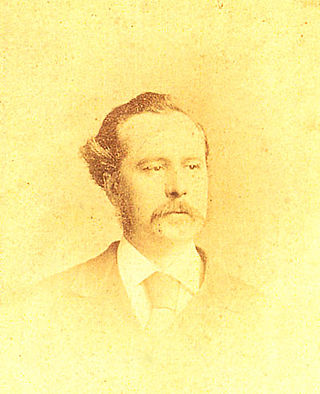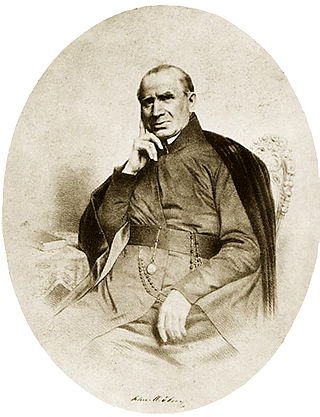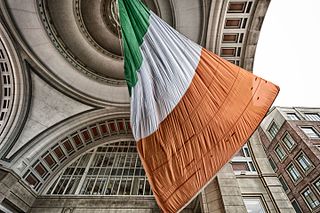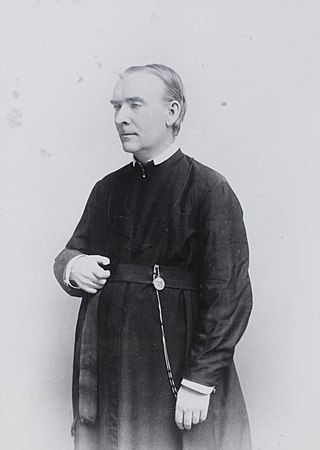
The Diocese of Albany is a Latin Church ecclesiastical territory in eastern New York in the United States. Its mother church is the Cathedral of the Immaculate Conception in Albany.

Edward Welby Pugin was an English architect, the eldest son of architect Augustus Welby Northmore Pugin and Louisa Barton and part of the Pugin & Pugin family of church architects. His father was an architect and designer of Neo-Gothic architecture, and after his death in 1852 Edward took up his practice. At the time of his own early death in 1875, Pugin had designed and completed more than one hundred Catholic churches.

The Diocese of Columbus is a Latin Church ecclesiastical territory, or diocese, of the Catholic Church covering 23 counties in central Ohio in the United States. It is a suffragan diocese in the ecclesiastical province of the metropolitan Archdiocese of Cincinnati.

Carney Hospital is a small for-profit community teaching hospital located in the Dorchester neighborhood of Boston, Massachusetts. It is owned and operated by Dallas-based Steward Health Care.

Saint John's Catholic Prep is a private, Roman Catholic, coeducational, college preparatory high school in Buckeystown, Maryland, located just southwest of Frederick City. At the time of its founding in 1829, it was located on Second Street in eastern downtown Frederick. Beginning in 1958 and for 45 years thereafter, the school was housed in the historic "Prospect Hall" mansion, (1787–1803), also just southwest of Frederick. St. John's was the first independent Roman Catholic school in the state of Maryland. It was also the first Roman Catholic secondary school in the state of Maryland.
James Francis Carney was a Canadian archbishop of the Roman Catholic Church. He served as the eighth Archbishop of Vancouver, British Columbia, from 1964 until he died in 1990. He was the first Archbishop of Vancouver born in the city of Vancouver.

John McElroy was a Jesuit priest who founded Catholic schools in the United States. After emigrating to the United States in 1803, McElroy enrolled in Georgetown University in 1806, the same year in which he joined the Society of Jesus as a lay brother. His brother Anthony also became a Jesuit. McElroy assumed the management of Georgetown's financial affairs. He was ordained a priest in 1817. In 1822 he was sent to Frederick, Maryland, where he was to remain for 23 years as pastor of St. John the Evangelist Catholic Church in downtown Frederick. It was in Frederick that he founded St. John's Literary Institution. During the Mexican–American War, McElroy served as an Army chaplain, and on his return from Mexico he went to Boston, where he established Boston College and Boston College High School.

The Shrine of the Immaculate Conception is a Roman Catholic church in downtown Atlanta, Georgia, United States. The current church building was completed in 1873 and is the oldest church in Atlanta, as well as one of the oldest standing buildings in the city. It was added to the National Register of Historic Places in 1976.
John Bernard Delany was an American prelate of the Roman Catholic Church. He served as bishop of the Diocese of Manchester in New Hampshire from 1904 to 1906.

John Joseph Conroy was an Irish-born clergyman of the Roman Catholic Church. He served as Bishop of Albany from 1865 to 1877.

The Church of the Immaculate Conception is a parish church in the Roman Catholic Archdiocese of New York, located at 414 East 14th Street, near First Avenue, Manhattan, New York City, and previously at 505 East 14th Street.

People of Irish descent form the largest single ethnic group in Massachusetts, and one of the largest in Boston. Once a Puritan stronghold, Boston changed dramatically in the 19th century with the arrival of immigrants from other parts of the world. The Irish dominated the first wave of newcomers during this period, especially following the Great Irish Famine. Their arrival transformed Boston from an Anglo-Saxon, Protestant city into one that has become progressively more diverse. These people hired Irish as workers and servants, but there was little social interaction. In the 1840s and 50s, the anti-Catholic, anti-immigrant Know Nothing movement targeted Irish Catholics in Boston. In the 1860s, many Irish immigrants fought for the Union in the American Civil War, and that display of patriotism helped to dispel much of the prejudice against them.

St. Michael's Roman Catholic Church is an active parish of the Roman Catholic Archdiocese of Philadelphia located at Second and Jefferson Streets in Philadelphia, in the West Kensington section of the city.
Diedrich Augustus Bohlen a native of Cadenberge, Kingdom of Hanover, immigrated to the United States around 1851 and founded D. A. Bohlen, Architect, in 1853 at Indianapolis, Indiana. In 1971 it became Bohlen, Meyer, Gibson and Associates, and is among the oldest architectural firms in the United States still in operation. Bohlen is best known for introducing the German Neo-Gothic architecture style to Indiana. Bohlen and his firm specialized in institutional projects, especially civic, religious, and educational buildings. More than forty of the firm's projects are listed on the National Register of Historic Places, including several of D. A. Bohlen's designs: Morris-Butler House (1864); Saint John the Evangelist Catholic Church (1871), its rectory (1863), and bishop's residence (1878); Indianapolis's Roberts Park Methodist Church (1876) and Crown Hill Cemetery's Gothic Chapel (1877); and in collaboration with his son, Oscar D. Bohlen, the Indianapolis City Market (1886). The combined campus of Saint Mary-of-the-Woods College and the Sisters of Providence of Saint Mary-of-the-Woods make up the Saint Mary-of-the-Woods Historic District, the largest cohesive collection of Bohlen buildings. The District is of statewide significance on the National Register of Historic Places, for its contribution to architectural, educational and religious history.

The Church of the Immaculate Conception, commonly known as Immaculate Conception St. Mary's Church, or simply St. Mary's Church, is a Catholic parish and church located in Yonkers, New York. It is the oldest Catholic parish in Yonkers.

John Dunning Whitney was an American Catholic priest and Jesuit who became the president of Georgetown University in 1898. Born in Massachusetts, he joined the United States Navy at the age of 16, where he was introduced to Catholicism by way of a book that accidentally came into his possession and prompted him to become a Catholic. He entered the Society of Jesus and spent the next twenty-five years studying and teaching mathematics at Jesuit institutions around the world, including in Canada, England, Ireland, and around the United States in New York, Maryland, Boston, and Louisiana. He became the vice president of Spring Hill College in Alabama before being appointed the president of Georgetown University.

Edward Ignatius Devitt was a Canadian American priest, Jesuit, and historian of the American Catholic Church. Born in Saint John, New Brunswick, he moved with his family to Boston, Massachusetts, at a young age. He studied in public schools in the city before enrolling at the College of the Holy Cross. Devitt spent two years there, and then entered the Society of Jesus in 1859. He studied at the novitiate in Frederick, Maryland, and at the newly opened Woodstock College. He briefly taught at the Washington Seminary during his studies, and after graduating, was a professor for the next thirty years at Holy Cross, Woodstock, and Georgetown University.

Sister Ann Alexis Shorb (1805–1875) of the Daughters of Charity of St. Vincent de Paul was a nurse, educator, and hospital administrator. Through her work serving the poor in schools and as a nurse, Shorb helped to break down anti-Catholic prejudice. She was known as the "Servant of the Poor." Before becoming a sister, she was a member of St. Aloysius Church in Littlestown, Pennsylvania.

Timothy Francis Walsh was an American architect and partner in the firm Maginnis, Walsh and Sullivan and Maginnis & Walsh who designed more than 115 ecclesiastical buildings and numerous university buildings over the course of his career.



















